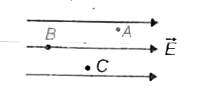A charge of experiences a force of when it is kept in a uniform electric field. What is the potential difference between two points separated by a distance of ?
The correct Answer is:A
To solve the problem, we will follow these steps:
Step 1: Understand the relationship between force, charge, and electric field
The force F experienced by a charge q in an electric field E is given by the formula:
F=q⋅E
Where:
- F is the force in newtons (N)
- q is the charge in coulombs (C)
- E is the electric field in newtons per coulomb (N/C)
Step 2: Calculate the electric field
We can rearrange the formula to solve for the electric field E:
E=Fq
Substituting the given values:
- F=5000N
- q=5C
Calculating E:
E=5000N5C=1000N/C
Step 3: Understand the relationship between electric field and potential difference
The potential difference V between two points in a uniform electric field is given by:
V=E⋅d
Where:
- V is the potential difference in volts (V)
- E is the electric field in newtons per coulomb (N/C)
- d is the distance in meters (m)
Step 4: Convert distance from centimeters to meters
The distance given is 1cm. We need to convert this to meters:
d=1cm=0.01m
Step 5: Calculate the potential difference
Now we can substitute the values into the formula for potential difference:
V=E⋅d=1000N/C⋅0.01m
Calculating V:
V=10V
Final Answer
The potential difference between the two points separated by a distance of 1 cm is 10V.
---
The force F experienced by a charge q in an electric field E is given by the formula:
F=q⋅E
Where:
- F is the force in newtons (N)
- q is the charge in coulombs (C)
- E is the electric field in newtons per coulomb (N/C)
We can rearrange the formula to solve for the electric field E:
E=Fq
Substituting the given values:
- F=5000N
- q=5C
E=5000N5C=1000N/C
The potential difference V between two points in a uniform electric field is given by:
V=E⋅d
Where:
- V is the potential difference in volts (V)
- E is the electric field in newtons per coulomb (N/C)
- d is the distance in meters (m)
The distance given is 1cm. We need to convert this to meters:
d=1cm=0.01m
Now we can substitute the values into the formula for potential difference:
V=E⋅d=1000N/C⋅0.01m
Calculating V:
V=10V
The potential difference between the two points separated by a distance of 1 cm is 10V.
Topper's Solved these Questions
- BOOK - A2ZCHAPTER - ELECTRIC POTENTIAL & CAPACITANCEEXERCISE - Relation Between Electric Field And Potential24videos
ELECTRIC POTENTIAL & CAPACITANCE
- BOOK - A2ZCHAPTER - ELECTRIC POTENTIAL & CAPACITANCEEXERCISE - Electric Potential Energy22videos
ELECTRIC POTENTIAL & CAPACITANCE
- BOOK - A2ZCHAPTER - ELECTRIC CHARGE, FIELD & FLUXEXERCISE - Section D - Chapter End Test29videos
ELECTRIC CHARGE, FIELD & FLUX
- BOOK - A2ZCHAPTER - ELECTROMAGNETIC INDUCTIONEXERCISE - Section D - Chapter End Test30videos
ELECTROMAGNETIC INDUCTION
Similar Questions
Knowledge Check
- Question 1 - Select One
A charge of 5C experiences a force of 5000N when it is kept in a uniform electric field. What is the potential difference between two points separated by a distance of 1cm ?
A10VB250VC1000VD2500V - Question 2 - Select One
A charge 3 coulomb experiences a force 300N when placed in a uniform electric field. The potential difference between two points separated by a distance of 10cm along the field line is:
A10VB90VC1000VD9000V - Question 3 - Select One
For uniform electric field, potential difference between the plate is
A1ε0QAdB1ε0AdQCε0QAdD1ε0QdA
In a region,uniform electric field is 10Vm ,then potential difference between two points which are separated by 3m may be equal .??
View SolutionWhat is the potential difference between two points in the electric field? Name its SI unit.
View SolutionWhen a charge of 3 coulombs is placed in a uniform electric field, it experiences a force of 3000 netwon. Within this field, potential difference between two points separated by a distance of 1cm is
View SolutionA 5C charge experience a force of 2000N when moved between two points separated by a distance of 2cm in a uniform electric field. The potential difference between the two points is
View SolutionA, B and C are three points in a uniform electric field. The electric potential is
 View Solution
View Solution

